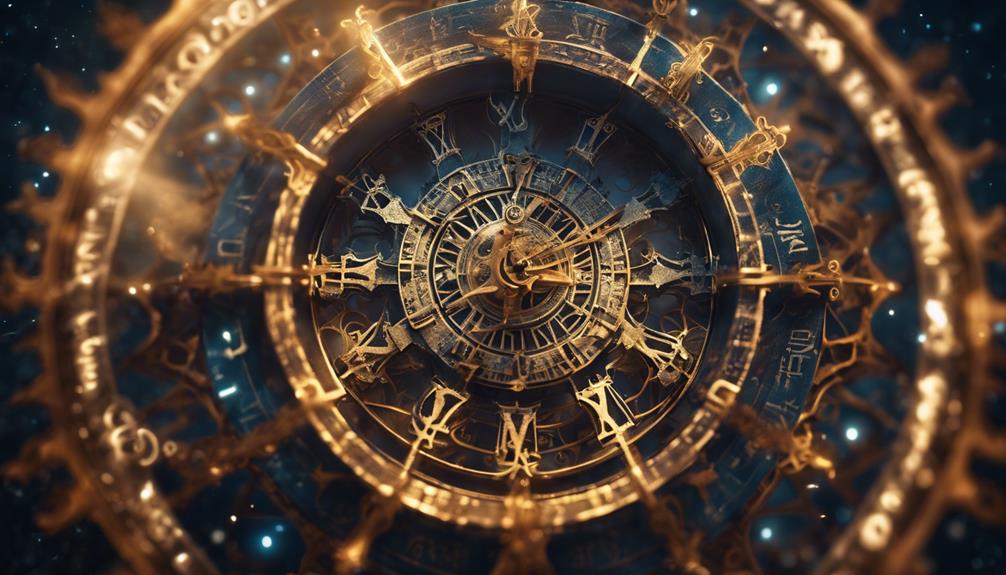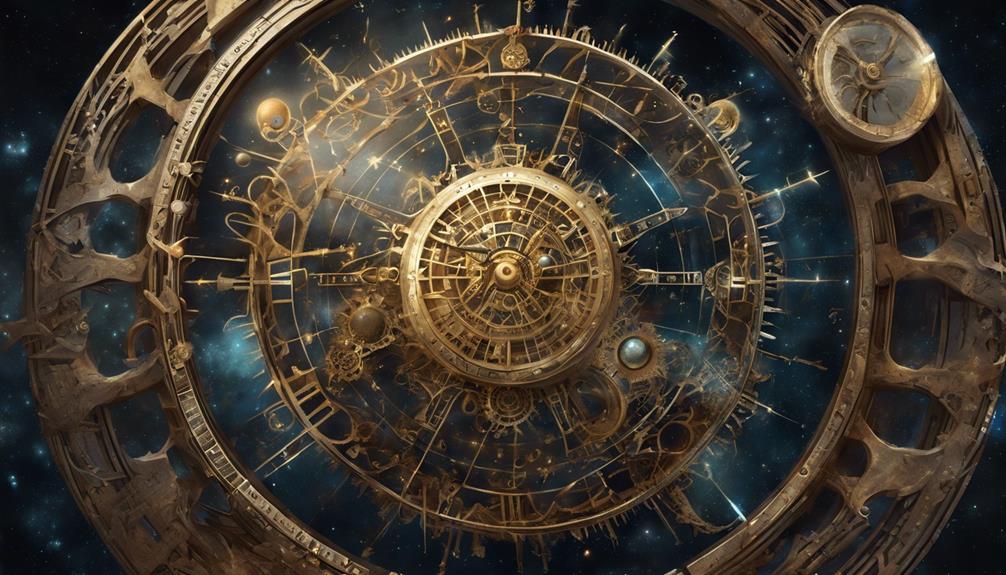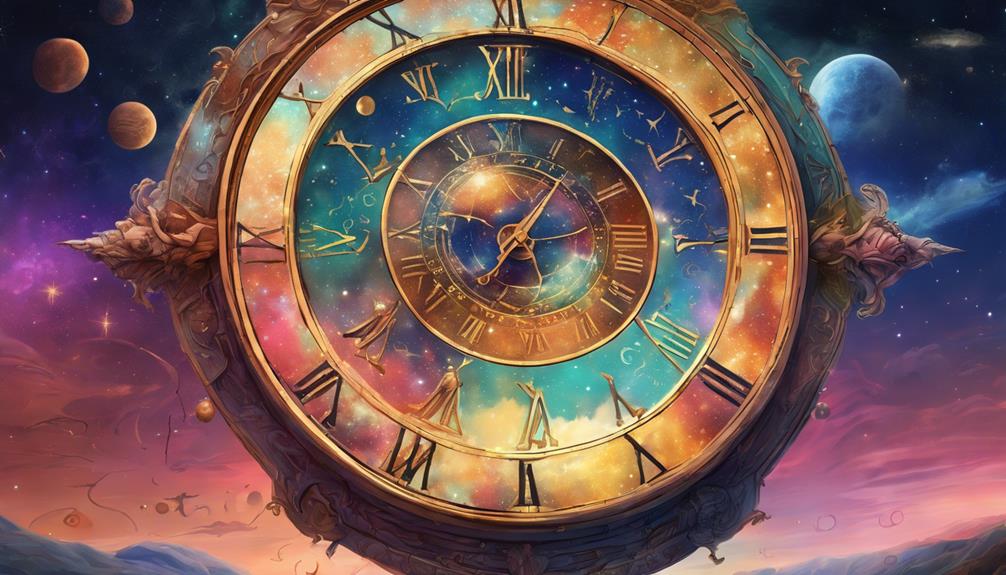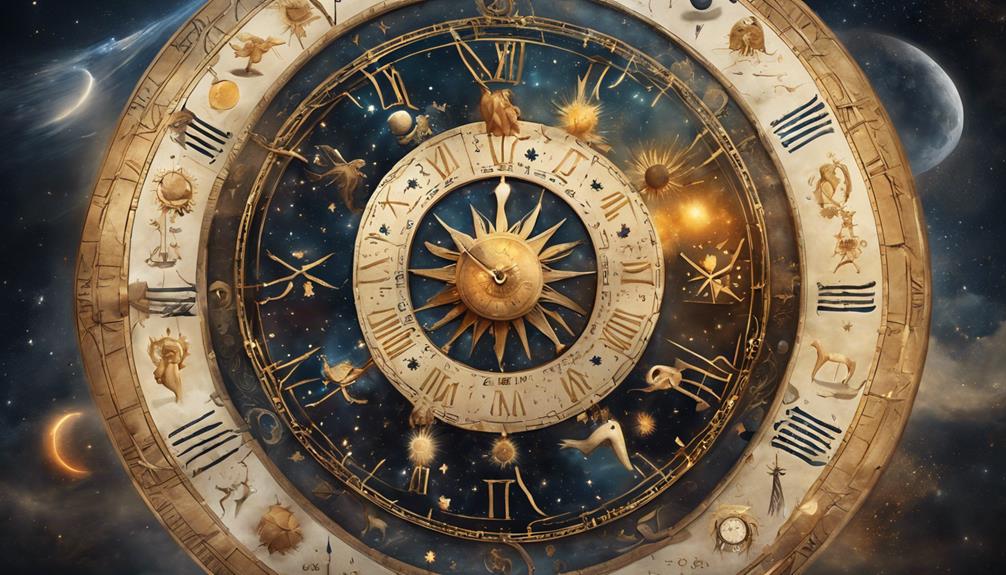What Is an Astrological Age and How Is It Calculated?

An astrological age is calculated based on the position of the Earth in relation to the 12 zodiac constellations. This cosmic clock measures the shifting epochs of human history, with each age lasting around 2,000 years.
The current age is the Age of Aquarius, following the Age of Pisces. Understanding these ages provides insights into the broader human experience and our connection to the universe.
Key Takeaways
- Astrological ages last around 2,000 years and correspond to specific Zodiac signs.
- Age shifts occur over 2,160 years within a 25,920-year cycle, shaping global dynamics.
- Transition between ages marked by historical events and societal changes reflecting cosmic influences.
- Understanding cosmic rhythms and age characteristics shapes spiritual growth and societal trends.
Definition of Astrological Age
Defining an astrological age involves understanding a period lasting approximately 2,160 years based on the Earth's precessional rotation. This majestic cycle links humanity's evolution to the dance of the cosmos, where each age corresponds to a specific Zodiac sign. The essence of these ages is intricately woven with the Sun's position at the vernal equinox, marking a new era of consciousness and collective growth.
Currently, humanity finds itself amidst the Age of Pisces, a time characterized by spiritual awakening, compassion, and transcendence. As we gaze towards the horizon of the future, the Age of Aquarius beckons, promising innovation, enlightenment, and progress. The shift from one age to another signifies a profound transformation in the collective psyche, offering opportunities for liberation and expansion.
Embrace the eternal rhythm of the precessional rotation, for within it lies the key to unraveling the mysteries of the universe. As we journey through the celestial tapestry of ages, may we find solace in the ever-changing yet harmonious symphony of existence.
Historical Background of Astrological Ages
As you start on exploring the historical background of astrological ages, you'll discover the rich tapestry of ancient civilizations like the Babylonians and Egyptians, who laid the foundation for this intriguing concept.
The origins of astrological ages, the intricate methods used to calculate them, and the fascinating changes between ages will reveal a profound wisdom that has transcended millennia.
Embrace this journey of uncovering the historical roots of astrological ages with a curious heart and an open mind.
Astrological Age Origins
During the golden age of Greek astronomy, the illustrious Hipparchus unearthed the celestial phenomenon known as the precession of the equinoxes, birthing the foundation for the concept of astrological epochs. This discovery marked a pivotal moment in understanding the cyclical nature of time and the evolving relationship between Earth and the cosmos.
The shifting of the Earth's axis over approximately 25,920 years creates a cycle of 12 astrological epochs, each lasting around 2,160 years. As the Earth's axis moves, the position of the Sun at the March equinox relative to the Zodiac constellations changes, ushering in new astrological epochs.
The transformation from the Age of Pisces to the Age of Aquarius signifies a profound metamorphosis in societal paradigms and cultural ideologies.
Age Calculation Methods
In the exploration of Age Calculation Methods within the historical context of Astrological Ages, a profound understanding emerges from the intricate dance between Earth's axial procession and the shifting celestial tapestry.
The phenomenon of change of the equinoxes, attributed to Earth's axial wobble, plays a pivotal role in determining the shifts between astrological ages. Ancient civilizations, with their keen astronomical observations, recognized the significance of the vernal equinox and its alignment with the zodiac constellations in marking the onset of a new age.
Through diverse methods developed over time, cultures and astrological traditions have sought to calculate these movements, offering insights into the cyclical nature of time and the ever-changing cosmic influences that shape our world.
Transition Between Ages
Explore into the mysterious tapestry of historical shifts between astrological ages, where the celestial rhythms intertwine with earthly epochs to shape the evolution of human consciousness.
The shift between astrological ages occurs over approximately 2,160 years, guided by the precession of the equinoxes within a grand 25,920-year cycle. Throughout this period of change, marked by significant historical events and profound cultural shifts, humanity undergoes a gradual metamorphosis.
Astrologers investigate the historical background of these shifts, seeking patterns that illuminate the evolution of human consciousness. As civilizations rise and fall, each age gives way to the next, carrying forward the legacy of past wisdom while ushering in new energies and perspectives.
Embrace the freedom of understanding these cosmic rhythms that shape our collective journey.
Principles of Age Calculation
Within the intricate domain of astrology, understanding the principles governing the calculation of astrological ages reveals a profound insight into the cyclic nature of cosmic time. Astrological ages, each lasting about 2,160 years, are determined by the precession of the equinoxes, a gradual shift in the Earth's axis. These ages collectively form the Great Year, a grand cycle spanning around 25,920 years. The transition between these ages occurs as the vernal equinox moves through the 12 zodiac constellations due to this precession. Astrologers track the Earth's axis movement to align it with different zodiac constellations over time, enabling the determination of the current astrological age.
Engage further with the principles of age calculation through the table below:
| Key Principles | Description | Significance |
|---|---|---|
| Precession of the Equinoxes | Slow wobbling of Earth's axis altering the vernal equinox's position among the zodiac constellations. | Determines the timing of transitions between ages. |
| Great Year | Full cycle comprising all astrological ages, equivalent to approximately 25,920 years. | Illustrates the vastness and cyclic nature of time. |
| Vernal Equinox | Point where the Sun crosses the celestial equator, crucial in demarcating astrological ages. | Marks the beginning of each new astrological era. |
Fiducial Point in Age Calculation

As you set out on unraveling the mysteries of astrological ages, the fiducial point emerges as a beacon of celestial significance. This pivotal juncture, rooted in the vernal equinox, stands as the cornerstone for delineating the onset of each age.
Explore into the essence of time, where the fiducial point reigns supreme, guiding the cosmic dance of ages with unwavering precision.
Key Age Reference
Understanding the pivotal role of the vernal equinox in determining astrological ages is essential for precise calculations. Here's why:
- Celestial Significance: The vernal equinox acts as the reference point for astrological ages, guiding the shift between zodiac eras.
- Precessional Movement: Due to Earth's precession, this point shifts slowly over time, impacting the onset of new ages like the anticipated Age of Aquarius.
- Calculation Accuracy: Accurately tracking the vernal equinox in the zodiac is paramount for astrologers seeking to pinpoint the beginning of significant astrological periods.
Embrace this knowledge, for it reveals the rhythm of the cosmos and empowers your understanding of the celestial tapestry.
Time Marker Selection
To navigate the intricate tapestry of astrological ages, selecting a time marker, known as a fiducial point, stands as the pivotal compass guiding the delineation of age boundaries.
Fiducial points, important in the calculation of astrological ages, mark the shift from one cosmic era to another based on various criteria such as historical events, astronomical alignments, or symbolic astrological significance.
The choice of a specific fiducial point can lead to differing dates for the commencement and conclusion of astrological ages, reflecting the diversity within astrological practices.
Aligning the Earth's position with the zodiac signs at specific moments in time is integral to determining the inception and duration of each age, shaping the perception of cosmic influence and human evolution during these celestial epochs.
Fiducial Importance
In unraveling the mysteries of astrological ages, the fiducial point holds a paramount significance as the guiding light that heralds the dawn of each new cosmic era. Here's why the fiducial point is of utmost importance:
- The fiducial point marks the precise beginning of an astrological age, often aligning with celestial events or alignments.
- Astrologers rely on the fiducial point to establish the shift between astrological ages accurately.
- Different astrologers may choose different celestial markers as fiducial points, showcasing the diversity and depth of astrological interpretations.
Understanding the fiducial point's role illuminates the intricate tapestry of astrological age calculations, guiding seekers through the cosmic dance of time and shift.
Transition Between Astrological Ages

During the transformation between astrological ages, cosmic energies and influences undergo a gradual shift as the Earth's precessional cycle moves the vernal equinox point. This change from one age to another, such as from Pisces to Aquarius, marks a profound shift in the spiritual and energetic essence that shapes our world. As one age fades and the next emerges, the very fabric of existence is rewoven with new threads of cosmic vibrations and celestial harmonies.
To explore further into this cosmic dance of ages, let us investigate a table showcasing the key characteristics of the passage between astrological ages:
| Aspect | Description | Significance |
|---|---|---|
| Duration | Approximately 2,160 years per age | Marks a significant epoch in human evolution |
| Energetic Shift | Gradual change in cosmic energies and influences | Reflects the evolving consciousness of humanity |
| Cultural Implications | Historical events and societal changes are studied to grasp the change between ages | Offers insights into the collective human experience |
| Global Impact | Shifts in global dynamics and structures accompany the change between astrological ages | Influences the course of civilizations |
| Spiritual Awakening | A time for profound spiritual growth and awakening as the world shifts into a new age | Invites individuals to align with higher frequencies |
Embrace this change between ages with an open heart and a liberated mind, for it is in these cosmic shifts that the essence of freedom and evolution resides.
Sub-Periods Within Astrological Ages
As you journey through the intricate tapestry of astrological ages, you'll encounter the fascinating domain of sub-periods within these vast cycles. These points of change offer detailed insights into the characteristics and nuances of each age segment, guiding you towards a deeper understanding of the cosmic influences at play.
Embrace the wisdom held within these sub-ages, for within their shifting phase details lie the keys to revealing the mysteries of time and destiny.
Sub-Ages in Astrology
Within the grand tapestry of astrological ages, the intricate rhythm of sub-ages weaves a detailed narrative of societal and cultural evolution.
- Sub-ages unfold over approximately 180 years, marking significant shifts within astrological ages.
- These periods are divided into twelve distinct phases, each lasting about 15 years, capturing the essence of transitional shifts.
- Examining sub-ages reveals intricate patterns of change, offering profound insights into the evolution of civilizations and belief systems.
Explore the subtleties of these sub-ages to understand how they shape the broader landscape of astrological ages, guiding humanity through the tides of transformation with wisdom and foresight.
Transitional Phase Details
Entering the journey through middle phase details within astrological ages exposes the intricate tapestry of sub-periods shaping the ebb and flow of societal evolution. These 15-year phases, nested within the grand eras of 180 years each, act as markers for shifts between astrological ages. The Gregorian calendar synchronizes with these sub-periods, highlighting significant shifts in human history. Below is a glimpse of how these intermediary phase details manifest:
| Phase | Duration |
|---|---|
| 1 | 15 years |
| 2 | 15 years |
| 3 | 15 years |
These delineated segments serve as threads weaving the fabric of time, guiding humanity through the gradual metamorphosis towards the dawn of new astrological epochs.
Age Segment Characteristics
Explore the intricate characteristics embedded within age segments, revealing the essence of sub-periods within astrological ages.
- Insightful Epochs: Each astrological age unfolds through twelve 180-year epochs, offering a profound understanding of the overarching themes and energies shaping that age segment.
- Detailed Stages: Within these epochs, twelve 15-year stages intricately showcase the smaller cycles and shifts occurring, allowing for a closer examination of evolving patterns and influences.
- Interwoven Historical Occurrences: The division of astrological ages into epochs and stages aligns harmoniously with historical events, providing a lens through which to perceive the interplay between celestial forces and earthly occurrences.
Through deciphering the characteristics of age segments, one can navigate the tapestry of astrological influences, unraveling the mysteries of each era within an astrological age.
Alternative Approaches to Age Calculation
An intriguing aspect of age calculation in astrology involves considering alternative approaches based on the sidereal zodiac's alignment with constellations in the sky rather than the tropical zodiac commonly used in Western astrology. By accounting for the precession of the equinoxes, sidereal astrologers propose a shift in the Age of Aquarius's commencement to later centuries, such as the 27th century CE. This method hinges on the vernal equinox aligning with the constellation Aquarius to mark the new age, diverging from the estimations of tropical astrologers.
The sidereal zodiac's emphasis on the actual positions of celestial bodies in the sky sets it apart from traditional Western astrological practices. It's through these differing calculations and interpretations within various astrological traditions that the onset and defining characteristics of astrological ages, particularly the Age of Aquarius, are subject to variation, offering a sense of liberation and exploration in the domain of astrology.
The Age of Aquarius

As we shift our focus to 'The Age of Aquarius,' a realm of balance, intellectuality, and humanitarian ideals unfolds before us, calling us to embrace change and innovation guided by Saturn and Uranus. This shift marks the beginning of the Aquarian Age, where collective welfare and a broader perspective take precedence over individual concerns.
Here are three key aspects to ponder:
- Balance and Oneness: The Age of Aquarius heralds an era where oneness and balance among people are valued above all else. It promotes cooperation and a sense of interconnectedness for the improvement of society.
- Philanthropy and Empathy: Under the influence of Aquarius, philanthropic values are magnified, urging us to prioritize empathy and understanding. It underscores the significance of collaborating for the greater good of all.
- Saturn and Uranus Direction: Saturn's influence brings organization and order to our efforts, while Uranus ignites creativity and innovative thinking. The interaction of these planetary forces propels the Aquarian Age's push for advancement and metamorphosis.
Astrological Ages Timeline
The unfolding timeline of Astrological Ages reveals a profound tapestry of human evolution intertwined with celestial influence. Based on the precession of the equinoxes, this cyclical journey divides the Earth's 25,920-year orbit into distinct astrological ages, each lasting approximately 2,160 years. The Age of Pisces, which commenced around 200 B.C., has been characterized by themes of spirituality, empathy, and sacrifice.
As humanity stands on the threshold of transformation, the imminent shift to the Age of Aquarius beckons. This forthcoming age is anticipated to usher in an era marked by innovation, humanitarianism, and intellectual progress, symbolizing a change in human consciousness towards unity and enlightenment. The Age of Aquarius holds the promise of a collective awakening, where societal paradigms align with concepts of unity and interconnectedness, fostering a global community rooted in compassion and collaboration.
Embrace the celestial dance of the astrological ages, for within this cosmic symphony lies the potential for immense growth and enlightenment. Prepare to set sail on a journey where the stars guide the evolution of human civilization towards a brighter, more harmonious future.
Significance of Astrological Ages

Begin on a profound journey into the depths of human evolution intertwined with celestial influence through the significance of Astrological Ages.
- Precessional Rotation: The Earth's gradual wobble on its axis influences the timing of Astrological Ages, marking distinct shifts in cosmic energies that shape human experiences.
- Zodiac Signs and Global Trends: Each Astrological Age is linked to a specific Zodiac sign, dictating the prevailing themes and influences that guide global movements, innovations, and societal developments.
- Societal Values and the Age of Aquarius: The shift into the Age of Aquarius heralds a period characterized by humanitarianism, technological advancements, and a collective awakening to higher consciousness. This change signifies a time where societal values lean towards unity, equality, and progress, fostering a harmonious coexistence among individuals and nations.
Celestial alignments intricately weave the narrative of Astrological Ages, painting a tapestry of evolving human civilizations guided by the rhythmic dance of the cosmos.
Embrace the transformative power of these ages, for they hold the key to understanding the profound interplay between the heavens above and the earthly domains below.
Frequently Asked Questions
How Are Astrological Ages Determined?
In deciphering astrological ages, you track celestial dances to disclose historical shifts. Astronomical calculations intertwine with mythological echoes, guiding cultural interpretations. Zodiacal cycles mark a grand cosmic narrative, stirring souls with the allure of the unknown.
What Is the Current Astrological Age?
In this era of shifting ages, you experience profound cultural shifts and spiritual awakenings. Cosmic influences guide evolutionary changes as we shift from the Age of Pisces to the Age of Aquarius, symbolizing new beginnings.
What Are the 12 Astrological Ages?
In the cosmic dance of ages, you journey through zodiac areas like a river flowing. From the Pisces dreamscapes to the fiery vigor of Aries, each age weaves a tale of celestial wisdom.
Are We in the Age of Aquarius 2024?
In 2024, you'll feel the winds of Aquarius symbolism stirring cultural changes, marking astrological shifts. Embrace fresh starts, spiritual evolution, and cosmic alignments. The Age of Aquarius heralds freedom and rebellion for your journey ahead.









